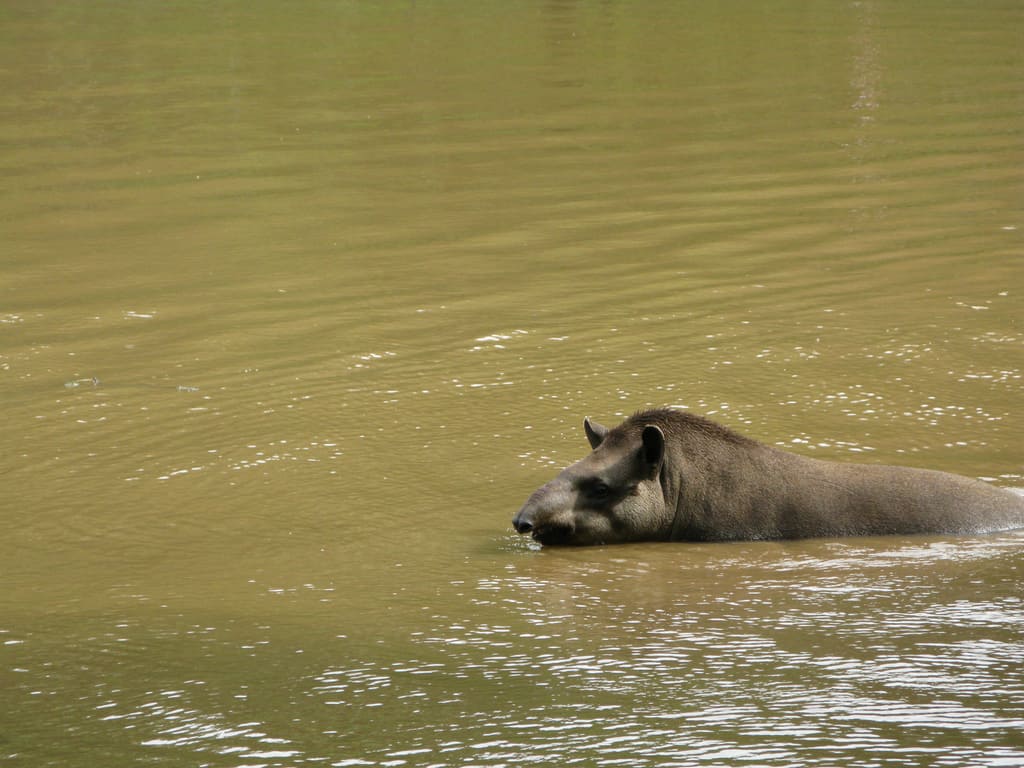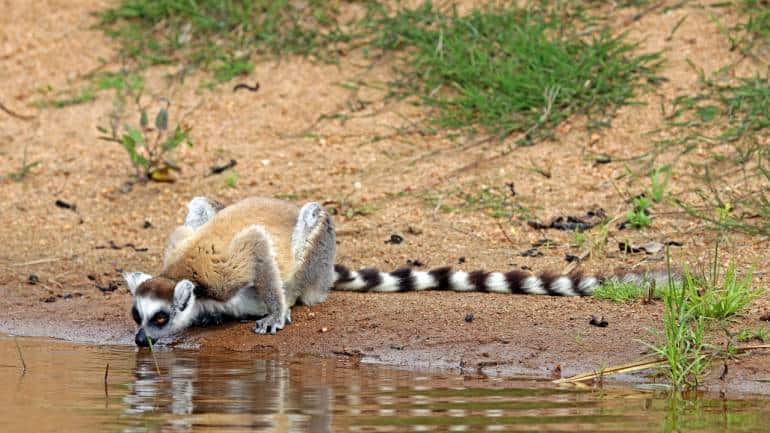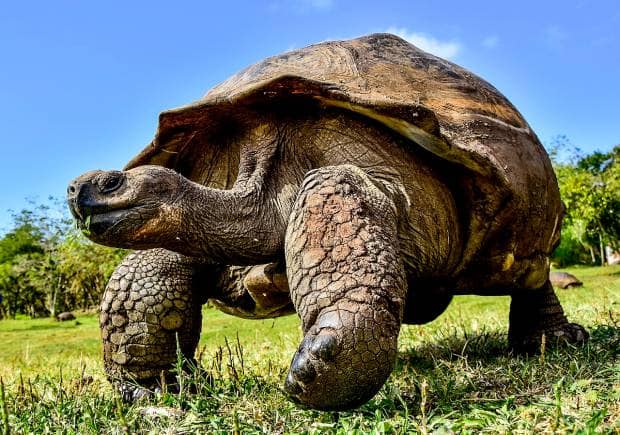Sea otters are guardians of underground kelp forests. (Photo by Dave Bezaire & Susi Havens-Bezaire via Wikimedia Commons)
In 1926, the last pack of grey wolves was eliminated at the tourist-favourite Yellowstone National Park in the US, as part of a policy to stamp out all predators. The effect on the ecosystem was staggering. Elk populations exploded, resulting in overgrazing of willows and aspens and carbon dioxide being released back into the atmosphere. Songbirds that depended on the trees disappeared. Beavers stopped building dams as riverbanks eroded. The water temperature rose so much that cold water fish could no longer thrive in it.
By 1995-96, 31 wolves were reintroduced to their historic range. Elk populations reacted immediately, trees rebounded, riverbanks stabilised, and birds and beavers returned. Till date, it is celebrated as one of the greatest stories ever to showcase the influence a single species has on an entire ecosystem.
The Earth is today experiencing its sixth mass extinction event, driven by human activity and rising global temperatures. As per the WWF Living Planet Report 2022, in less than 50 years, the world has lost 69 percent of all mammal, fish, bird, reptile, and amphibian populations. But this biodiversity is critical for the health of our planet, in order to maintain a necessary balance and support life.
So, while we know that combating climate change helps save wildlife populations and their homes, the reverse is also true. Wildlife also plays a key role in regulating our climate and mitigating the effects of climate change. By protecting them, we can help save the planet, and by extension, ourselves.
 Grey wolf (Photo by Jacob W. Frank via Wikimedia Commons)
Grey wolf (Photo by Jacob W. Frank via Wikimedia Commons)
Bengal tiger
India’s national animal has a key role to play in maintaining the health of its natural world. As per the WWF, forests in which tigers are found contain three times the carbon density of forests and other landscapes where their population has been wiped out.
The presence of this species also limits human activity, preventing the further degradation of forests. Thus, the planet retains a major carbon sink, without which carbon would be released into the atmosphere and global warming would exacerbate.
Sight & See: Madhya Pradesh’s Bandhavgarh National Park offers the greatest chance to spot this majestic animal.
African elephant
The smallest of the three elephant species, African elephants prune the forest while foraging for food. They stomp out smaller, invasive plants and allow taller trees that store carbon to flourish. As per a study published in the journal Nature Geoscience, extinction of wild elephants would result in a 7 percent decline in carbon-storing vegetation. The average African elephant is also a living carbon sink, and can capture more than 9,000 tonnes of carbon in its lifetime.
Habitat loss and poaching, however, have wiped out about 90 percent of these mammals. As a result, African elephants are now critically endangered while African savanna elephants and Asian elephants are listed as endangered.
Sight & See: Head to the Garamba National Park in the Congo and get a glimpse of the gentle giant in wild.
Tapir
Estimates place the current deforestation level of the Amazon at 17 percent, and its tipping point at 20-25 percent. Once this tipping point is crossed, the world’s largest rainforest will no longer be able to generate rainfall and support its ecosystems, becoming a dry grassland over time. It also means the world would lose an important carbon sink.
Tapirs prefer to frequent degraded habitats. The large terrestrial animals leave trails of seeds in their waste as they explore areas in the Amazon that were burned or cut down. A study identified 24 different species of seeds in tapir droppings, many of which become large trees that flourish in forests. These absorb additional carbon and play a critical role in slowing the warming of the planet.
Sight & See: Tambopata National Reserve in Peru is a must-visit for those looking to encounter a wild tapir.
 Tapirs can help burned or cut down areas of the Amazon bounce back. (Photo by Ventura B via Wikimedia Commons)
Tapirs can help burned or cut down areas of the Amazon bounce back. (Photo by Ventura B via Wikimedia Commons)
Great whales
Like elephants, great whales act as living carbon sinks. A single great whale, on average, can absorb 33 tonnes of CO2 throughout its lifetime. Their droppings are helpful too. As whales travel the oceans, they leave behind their waste that is rich in iron and nitrogen. This acts as a fertiliser for phytoplankton, which stores around 40 percent of all carbon dioxide produced globally.
Unfortunately, their populations have been decimated due to pollution and commercial whaling. If overall whale populations were allowed to return to around 4-5 million (from their current 1.5 million numbers), a massive 1.7 billion tons of carbon could be additionally stored each year.
Sight & See: The scenic St Lawrence River in Canada’s Quebec is a haven for up to 13 whale species, including the legendary blue whale.
Oysters
Earth’s temperature has risen by 0.08° Celsius per decade since 1880. However, the rate of warming since 1981 is more than twice that: 0.18° C per decade. As temperatures rise, so do sea levels, threatening marine life and coastal communities.
The small oyster can mount a powerful defence in such situations. Healthy oyster reefs act as walls and provide a buffer when storms strike. They also protect against coastal erosion and are a safe home for marine organisms, promoting biodiversity and ecosystem balance. An adult oyster filters 50 gallons of water in a day, making waterways cleaner.
Sight & See: Take a Nordic oyster safari to check them out.
Sea otters
Kelp are the ocean’s equivalent of trees, and cover a quarter of the world’s coastlines - from Australia to Antarctica. Kelp forests absorb up to 20 times more carbon per acre than land forests, and provide habitat for a wide variety of marine life.
The adorable sea otter acts as a guardian of these underwater forests. A keystone predator, it keeps sea urchin populations (who feed on kelp) in check. As per a study published in the journal Frontiers in Ecology and the Environment, kelp forests with sea otter guardians absorb 12 times more CO2 than those without.
Sight & See: Alaska’s Seward Small Boat Harbor attracts a variety of wildlife, from sea otters to seabirds.
 A Madagascar lemur. (Photo by Charles J Sharp via Wikimedia Commons)
A Madagascar lemur. (Photo by Charles J Sharp via Wikimedia Commons)
Lemurs and gibbons
Primates such as lemurs and gibbons are keepers of forests. They are crucial for tropical rainforests to flourish, since they aid in the dispersal of seeds of flowering plants and trees. A study published in Nature Scientific Reports examined a 30-hectare patch of forest in Thailand’s Khao Yai National Park, and found that one-third of stored carbon was sequestered in trees that grew from seeds dispersed by fruit-eating animals, including primates.It makes their conservation essential. A 2017 study published in Science Advances found that if Madagascar’s lemurs went extinct, a decline in native trees would most likely follow. Losing Thailand’s northern gibbons would have a similar impact.
Sight & See: Visit Madagascar to see 110 species of lemurs and Khao Yai National Park to meet Thailand’s most charismatic primate.
Giant tortoise
Thousands of tourists visit the Galapagos Islands every year to see its famous giant tortoise. The iconic species plays a crucial role on the islands by creating different habitat zones for other species in the archipelago through its long-distance migrations and seed dispersal. So much so that the seeds of some plants only germinate after they’ve been digested by the tortoises.
Their numbers are on the decline, and only around 15,000 now remain on the Galapagos. In fact, more than 50 percent of turtle and tortoise species globally face the threat of extinction.
Sight & See: The largest species of tortoise in the world can only be seen on seven of the Galapagos Islands.
 Giant tortoise (Photo by Felix Reyes Photography via Wikimedia Commons)
Giant tortoise (Photo by Felix Reyes Photography via Wikimedia Commons)
Malabar grey hornbill
Birds play many important roles in our forest ecosystems – as predators, pollinators, seed dispersers, scavengers and ecosystem engineers. In areas where hornbills are abundant, they can disperse up to 12,700 large seeds per day per square kilometre, which is critical for ecosystem function. The loss of such large-bodied frugivores would significantly reduce carbon storage in tropical forests.
The Malabar Grey Hornbill, for example, helps dispense large seeds in the Western Ghats. It is an indicator species and plays a crucial role in helping forests grow and thrive, thus indirectly supporting the local wildlife population and reducing human-animal conflict to a large extent.
Sight & See: Plan a holiday to the Anamalai–Parambikulam landscape to see this species in its natural habitat.
Beavers
While beavers are viewed as pests by some, they are in fact keystone species that have a critical role to play in the ecosystem. Beaver dams and the ponds they create help keep the soil moist and green vegetation alive. This can prevent wildfires even in drought years. Wildfires make up 5-10 percent of annual global CO2 emissions each year. The more fires are prevented, the less carbon dioxide will be released into the atmosphere.
Beaver ponds also store carbon. Beaver dams play a critical role for other wildlife, as they provide a reliable source of water.
Sight & See: River Otter and some of its tributaries in the US are home to beaver populations that can be seen from up close.